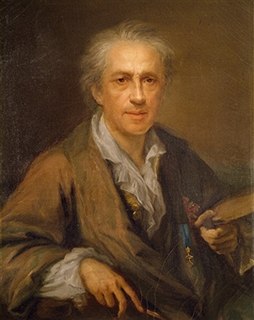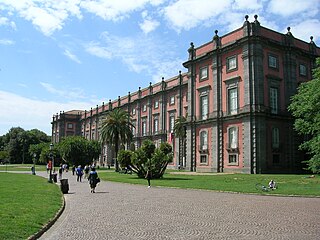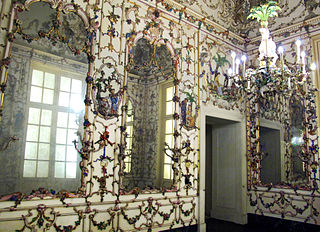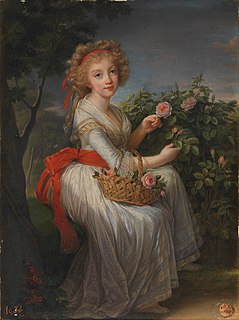
Museo di Capodimonte is an art museum located in the Palace of Capodimonte, a grand Bourbon palazzo in Naples, Italy. The museum is the prime repository of Neapolitan painting and decorative art, with several important works from other Italian schools of painting, and some important ancient Roman sculptures. It is one of the largest museums in Italy.

Maria Amalia of Saxony was Queen consort of Naples and Sicily from 1738 till 1759 and then Queen consort of Spain by marriage to Charles III of Spain, from 1759 until her death in 1760. The arranged marriage produced many children who survived into adulthood, including Charles IV of Spain. She was the daughter of Augustus III of Poland and his wife Maria Josepha.

Giuseppe Bonito was a Neapolitan painter of the Rococo period. Giuseppe Bonito is known for genre depictions on canvas. Many of Gaspare Traversi's paintings had previously been attributed to Bonito.

Capodimonte porcelain is porcelain created by the Capodimonte porcelain manufactory, which operated in Naples, Italy, between 1743 and 1759. Capodimonte is the most outstanding factory for early Italian porcelain, the Doccia porcelain of Florence being the other main Italian factory. Capodimonte is most famous for its moulded figurines.

Luisa of Naples and Sicily, was a Neapolitan and Sicilian princess and the wife of the third Habsburg Grand Duke of Tuscany.

The Portrait of Cardinal Alessandro Farnese is a portrait of cardinal Alessandro Farnese by Raphael, produced in 1509–11.

The Royal Palace of Portici is a former royal palace in Portici, Southeast of Naples along the coast, in the region of Campania, Italy. Today it is the home of the Orto Botanico di Portici, a botanical garden operated by the University of Naples Federico II. These gardens were once part of the large royal estate that included an English garden, a zoo and formal parterres.

The descendants of Charles III of Spain, the third surviving son of the first Bourbon King of Spain are numerous. Growing up in Madrid till he was 16, he was sent to the Italian Sovereign Duchy of Parma and Piacenza which, through his mother Elisabeth of Parma, was considered his birthright. Charles married only once, to the cultured Princess Maria Amalia of Saxony, with whom he had 13 children; 8 of these reached adulthood and only 4 of these had issue.

The Royal Palace of Capodimonte is a grand Bourbon palazzo in Naples, Italy, formerly the summer residence and hunting lodge of the kings of the Two Sicilies, and was one of the two Royal Palaces in Napoli. It today houses the National Museum of Capodimonte and art gallery of the city. "Capodimonte" means "top of the hill", and the palace was originally just outside the city, which has now expanded to surround it, and somewhat cooler than the city in summer.

Real Fábrica del Buen Retiro was a porcelain manufacturing factory in Spain. It was located in Madrid's Parque del Buen Retiro, Madrid on a site near the Fuente del Ángel Caído.

The Porcelain boudoir of Maria Amalia of Saxony is a rococo interior now located in the Palace of Capodimonte in Naples. It was originally made for the Palace of Portici in 1757–59, but has now been moved to the Capodimonte Palace.It is named after Maria Amalia of Saxony, queen of Naples. It consists of white porcelain panels decorated in high relief with festoons and genre scenes, drawing on the Chinoiserie popular at the time. It was designed by Giuseppe Gricci and produced in the Royal Porcelain Factory of Capodimonte, founded by Maria Amalia and her husband Charles of Bourbon in 1743.

Ferdinand I and His Family is a 1782 oil on canvas painting by Angelica Kauffman, now in Room 37 of the National Museum of Capodimonte in Naples.

Francis I and His Family is an 1820 oil on canvas painting by Giuseppe Cammarano, now in the National Museum of Capodimonte in Naples.

Portrait of Princess Maria Christina is an oil on canvas painting by Élisabeth Vigée Le Brun of Maria Christina, commissioned by her parents Maria Carolina of Austria and Ferdinand I of the Two Sicilies between 1775 and 1800. Vigée Le Brun had fled Paris in 1789 after the French Revolution and taken refuge in Naples. It is now in the National Museum of Capodimonte in Naples.

Portrait of Charles IV of Spain is a portrait of Charles IV of Spain in hunting dress with a hunting dog. Both it and a pendant of his wife were long thought to be a copy after an autograph work by Francisco Goya, but they have now been definitively reattributed as autograph works by Goya himself, produced late in the 18th century. Goya was a court artist to the royal family, though most of his paintings of them are still in the Prado Museum. The two works were commissioned by Charles's daughter Maria Isabella of Spain along with. It was sent to Maria Isabella and they are both now in the National Museum of Capodimonte in Naples.

Portrait of Maria Luisa of Parma is a portrait of Maria Luisa of Parma, wife of Charles IV of Spain, produced as a pendant painting to a portrait of her husband. Both works were long thought to be a copy after an autograph work by Francisco Goya, but they have now been definitively reattributed as autograph works by Goya himself, produced late in the 18th century. Goya was a court artist to the royal family, though most of his paintings of them are still in the Prado Museum. The two works were commissioned by the couple's daughter Maria Isabella of Spain. They were sent to Maria Isabella and they are both now in the National Museum of Capodimonte in Naples.

Portrait of Ferdinand IV is an 1759 painting by Anton Raphael Mengs, now in the National Museum of Capodimonte. It shows Ferdinand IV of the Kingdom of Naples, latter known as Ferdinand I of the Two Sicilies, and was commissioned by his mother Maria Amalia of Saxony to celebrate Ferdinand's accession to the throne of Kingdom of Naples aged eight after his father Charles of Bourbon's abdicated that throne to be king of Spain. This makes it the first official painting of the new king, produced by the artist in October 1759 in around a month, though it was critiqued by the other court artists Luigi Vanvitelli, Giuseppe Bonito and Francesco Liani, who had been passed over for the commission. Mengs also produced in 1760 a second copy of the painting, which was send to Ferdinand's parents to Madrid and which is now in the Prado Museum. Visually the main difference between the two paintings is the signature on 1760 copy, located on the square tile in bottom left corner.

Portrait of Philip II is an oil on canvas portrait by Titian of Philip II of Spain wearing the chain of the Order of the Golden Fleece. It is in the collection of the Museo di Capodimonte in Naples, Italy.

Equestrian Portrait of Charles of Bourbon is a mid-18th century oil on canvas portrait of Charles of Bourbon, produced by Francesco Liani towards the end of Charles' rule in Naples before becoming Charles III of Spain. Liani also produced a portrait of Charles' wife, Maria Amalia of Saxony. Both works are now in Room 34 of the National Museum of Capodimonte.
Francesco Liani was an Italian painter, mainly known for his portraits of the Neapolitan royal family.



















